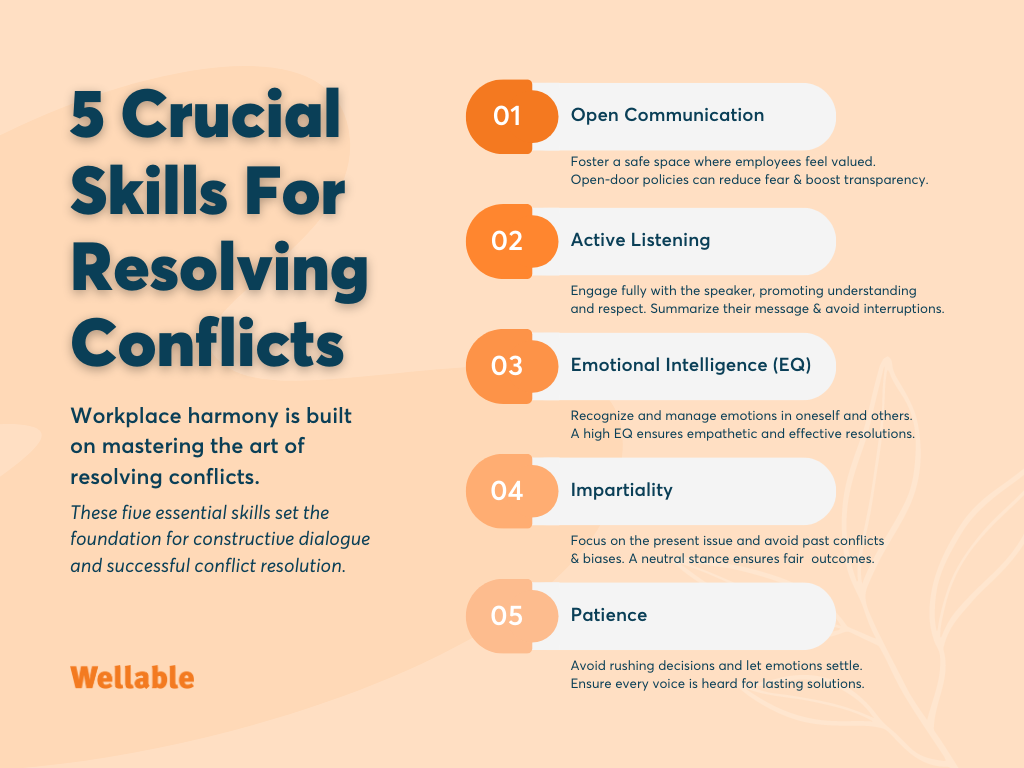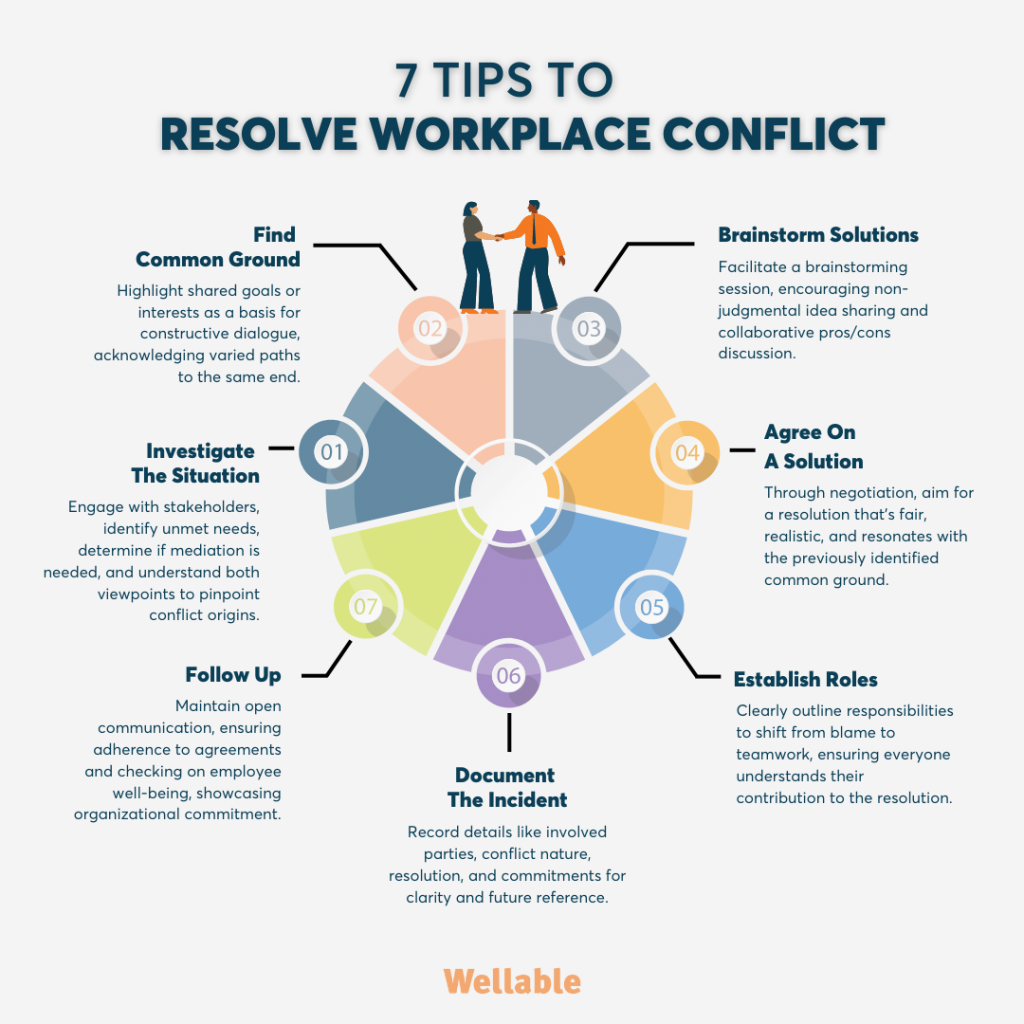
In the bustling hive of a modern workplace, clashing opinions, priorities, and aspirations are almost inevitable.
🖼️ Picture this: Two dedicated team members find themselves at odds over a critical project timeline. As deadlines loom and tensions rise, the once-cohesive partnership begins to crack under the weight of differing viewpoints. Amidst this turmoil, complaints to colleagues escalate the situation, underscoring the urgency of effective conflict resolution.
This scenario, while fictional, is all too familiar to anyone who has experienced the challenges of workplace dynamics. However, conflicts don’t necessarily indicate the downfall of collaboration. They can serve as catalysts for growth, understanding, and improved teamwork.
This article covers the “Three C’s” of conflict resolution, essential skills to navigate tense conversations, and a seven-step process to effectively manage conflicts in the workplace.
What Is Conflict Resolution?
Conflict resolution is the process of addressing and resolving disagreements, disputes, or conflicts between individuals or groups fairly and constructively.

The Three C’s Of Conflict Resolution
1. Communication: Effective communication involves actively listening to all parties involved, expressing oneself clearly and respectfully, and facilitating open and honest dialogue to understand and address underlying issues.
2. Collaboration: Collaboration involves working together to find mutually acceptable solutions. This includes brainstorming ideas, sharing perspectives, and seeking common ground to reach resolutions that consider the interests of all parties.
3. Compromise: Compromise involves finding a middle ground and making concessions to meet the needs of both sides. It requires a willingness to give and take, ensuring that no single party’s desires dominate the outcome.
These principles form a foundation for productively navigating conflict.
5 Conflict Resolution Skills
Effective workplace conflict resolution often relies on several universal skills, including:
1. Open Communication

Transparent dialogue creates a work environment where individuals feel safe, heard, and valued. To catch conflict early, managers should consider implementing an open-door policy. This encourages employees to reach out to management for conflicts of importance without fear of repercussion.
2. Active Listening

Active listening is a cornerstone skill in effective conflict resolution. It involves giving undivided attention to the speaker, understanding their perspective, and acknowledging their emotions. Practicing active listening may include:
- Using open body language, such as facing the speaker and keeping arms uncrossed
- Maintaining eye contact
- Nodding
- Paraphrasing or summarizing the speaker’s points
- Avoiding interrupting
This not only ensures accurate comprehension but also fosters a sense of validation and respect for the other person’s viewpoint. With open minds and open ears, conflicts can be de-escalated and pave the way for collaborative problem-solving.
3. Emotional Intelligence

Emotional intelligence involves recognizing and regulating one’s emotions while empathetically perceiving and addressing the emotions of others. By staying attuned to emotional cues and nonverbal signals, individuals can navigate tense situations with sensitivity and tact.
Emotional intelligence allows conflict resolvers to guide discussions in a manner that considers the underlying feelings and concerns of all parties involved. This fosters a more conducive environment for finding common ground and reaching mutually beneficial resolutions.
4. Impartiality

Resolving conflict becomes increasingly difficult when individuals stray away from the problem at hand. When navigating conflict, avoid these pitfalls:
- Bringing up unrelated previous conflicts
- Attacking character or personal traits
- Making assumptions based on personal biases
Impartiality allows parties to fairly assess the situation, consider diverse viewpoints, and make well-informed decisions that prioritize the best interests of the organization and its employees. This skill fosters trust and confidence, resulting in balanced and equitable outcomes that contribute to a harmonious workplace.
5. Patience

The nature of workplace conflicts often demands time for issues to unravel, emotions to settle, and perspectives to clarify. Practicing patience means refraining from rushing to conclusions or decisions prematurely.
Even if there appears to be an obvious solution, it’s important to allow ample time for all parties to feel involved in the decision-making process. Give individuals the space and time they need to fully express themselves and ensure that all relevant information is brought to the table.

7 Proven Steps To Resolve A Conflict In The Workplace
The following framework can be employed to effectively manage conflicts in the workplace, integrating the essential skills mentioned above.
1. Investigate The Situation

When conflict arises in the workplace, the first step is to conduct a thorough investigation into the matter. This includes:
- Speaking with involved parties to understand what needs are not being met
- Asking questions about what outcomes each party would like to achieve
- Determining if employees can work out the issue on their own or if a third party is needed (i.e., HR, management, etc.)
Thoroughly understanding both sides of the dispute ensures an accurate representation of the situation and allows the root causes to be determined before proceeding.
2. Find Common Ground

Finding common ground in workplace conflict resolution entails pinpointing shared goals, values, or interests that can serve as a foundation for constructive dialogue. Oftentimes, both parties are working towards the same goal but have differing viewpoints on how to achieve it.
Recognizing commonalities helps create a sense of unity and opens the door for more productive discussions, as individuals can begin to see beyond their differences and work toward a mutually beneficial resolution.
3. Brainstorm Potential Solutions

With common ground established, the next step is to facilitate a brainstorming session to generate potential solutions. Those who are managing workplace conflict resolution can encourage the parties to contribute ideas without judgment, discussing the pros and cons of each solution in a collaborative way.
4. Agree On A Solution

Next step is to negotiate and agree upon the most suitable resolution. This may involve compromise and open dialogue, where each party has the opportunity to voice their preferences and concerns. Both parties should strive for a solution that is fair, realistic, and aligns with the common ground identified earlier. Achieving consensus ensures that all parties have a vested interest in the resolution’s success.
5. Establish Responsibilities

By clearly defining the roles and responsibilities of those involved, everyone will be aware of their contributions toward the resolution process. By delineating responsibilities, the focus shifts from finger-pointing to collaborative problem-solving, creating a sense of ownership and accountability. This clears the path for a more streamlined and efficient conflict resolution process, where all individuals work together to achieve a mutually satisfactory outcome.
6. Document The Incident

A document of the incident serves as an official record that can be referred to in the future if needed. The following details could be included:
- The parties involved
- The nature of the conflict
- The chosen resolution
- Actions or commitments made
This provides clarity and accountability, reducing the likelihood of misunderstandings down the line. It also helps employers monitor common causes of problems within the workplace and identify employees who may be toxic to the environment.
7. Follow Up

Once a conflict is resolved, relationships don’t always return to normal. Maintaining open lines of communication after reaching a solution prevents regression in progress and the emergence of new issues. This includes checking in with the individuals involved and ensuring both sides of the agreement are upheld. Ongoing communication demonstrates an organization’s commitment to the welfare of employees and dedication to maintaining a healthy work environment.

Conclusion
Effective workplace conflict resolution transcends mere agreement. It creates an environment where diverse viewpoints come together, solutions arise from unique angles, and unity prevails amidst differences. Both employers and individuals can adopt conflict resolution strategies to turn challenges into prospects. This nurtures a workplace where conflicts, handled with empathy and expertise, lead to a future characterized by collaboration, collective well-being, and shared achievements.












